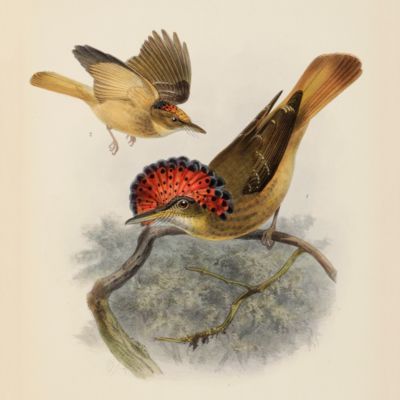Salvin, O. and F. D. Godman
Biologia Centrali Americana. Aves.
London, [the authors], 1879-1904. In four volumes. Large 4to-folio mix (31.0 x 24.6 cm). 1673 pp. (I. Temporary title page (1879-1887), xliv, 512 pp.; II. Temporary title page (1888-1897) [ii], 598 pp.; III. Title page (1897-1904), [iii-iv], 510 pp; IV (atlas): title page to the atlas, [iii]-vii pp. [list of plates]); 84 lithographed plates, originally hand-coloured [numbered 1-79, 15a, 54a, 58a, 58b, 59a]. Uniform black, pebbled half morocco over green pebbled cloth. Spines with five raised bands, gilt title and number.
Arguably one of the most important and certainly the most beautifully illustrated part of an immense series, of which all parts are scarce, if not rare. All but two of the fine plates are by the great Anglo-Dutch bird painter John Gerrard Keulemans (1842-1912). The area covered extended from Mexico (usually regarded as part of North America) to Panama, with additional information on bird species' distribution and occurrence north and south of this region. Keulemans and Coldeway report 82 plates by Keulemans. Plates 64 and 66 are by the British bird artist Edward Neale (1833-1904). The Biologia Centrali-Americana is a series of monographs of the natural history of Mexico and Central America, privately issued in 215 parts from 1879 to 1915 by the editors, and authors of the bird part, the British entomologist (chiefly Lepidopterologist) and ornithologist Frederick DuCane Godman (1834-1919) and the British ornithologist Osbert Salvin (1835-1898), who both worked for the British Museum (Natural History) in London. After Salvin's death, two other British ornithologists, Richard Bowdler Sharpe (1847-1909) and the Scottish ornithologist William Robert Ogilvie-Grant (1863-1924) assisted Godman in completing the work. This whole work is still fundamental for the study of Neotropical animals, because it contains almost all that was known of the biodiversity of Mexico and Central America at the time of its publication. The whole series has 63 volumes with 1,677 lithograph plates (more than 900 of which are in colour) depicting 18,587 subjects. In total, 50,263 species are treated, of which 19,263 are described as new. The bird section deals with 1,413 species representing 78 families and 539 species (Anker). These four volumes form Volumes 3 to 6 of the whole Series (see Lyal, who also provides publication dates). A few volumes of Biologia Centrali-Americana were (photomechanically) reprinted, but not this part on birds. The series is rare, even in institutional libraries. Joints of the second to fourth text volumes and atlas rubbed to a greater or lesser extent; Otherwise excellent, clean, unmarked: a superior, complete set. Anker, 437; Keulemans and Coldewey, Feathers to a Brush. The Victorian Bird Artists John Gerrard Keulemans. 1842-1912, p. 64; Lyal, C. H. C. (2011), The Dating of the Biologia Centrali-Americana, pp. 67-100 in Zoological Bibliography 2011(1); Sitwell, Fine Bird Books, p. 138; Zimmer, pp. 541-542.




